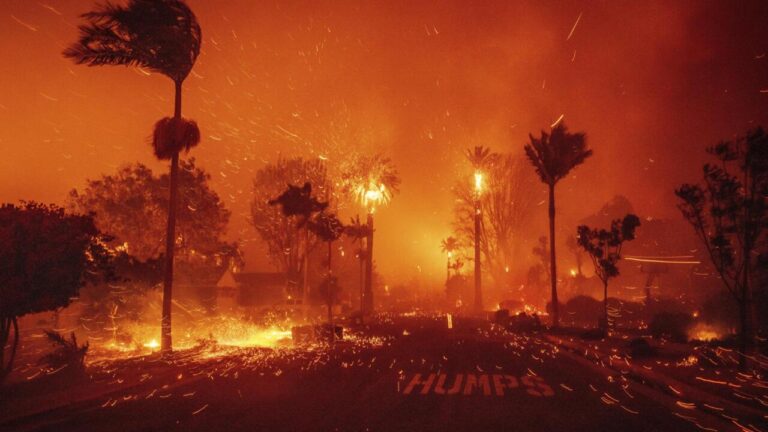Los Angeles Wildfires Escalate: Comprehensive Update on Evacuations and Firefighting Efforts
Rapid Wildfire Expansion Threatens Thousands of Homes in Los Angeles
Intense wildfires have rapidly spread across multiple regions in Los Angeles County,forcing thousands of residents to evacuate as flames advance under extreme weather conditions. The combination of persistent dry winds and record-high temperatures has exacerbated the fire’s growth,creating a volatile environment for firefighting teams. Emergency officials stress the critical need for residents to comply with evacuation orders to ensure public safety.Complicating the response are widespread power outages and numerous road closures, which have slowed evacuation and relief operations. Emergency shelters are filling quickly as displaced families seek refuge.
Current wildfire statistics and updates include:
- Evacuation zones: More than 20 neighborhoods impacted, including Pacoima and Northridge
- Containment status: Fire containment remains under 30%, with ongoing suppression efforts
- Firefighting resources: Deployment of over 600 firefighters supported by air tankers and helicopters
- Environmental consequences: Thick smoke plumes deteriorating air quality across the metropolitan area
| Neighborhood | Evacuated Residents | Containment Percentage |
|---|---|---|
| Pacoima | 5,500+ | 27% |
| Northridge | 3,400 | 29% |
| Sun Valley | 3,000 | 23% |
Coordinated Evacuations and Firefighting Operations in Progress
As the wildfires continue to consume large swaths of land, emergency officials have issued mandatory evacuation orders for thousands of residents in vulnerable areas. Fire crews from across California have been mobilized to tackle multiple fire fronts, contending with gusty winds and parched vegetation that accelerate the blaze. Designated evacuation centers have been set up in safer locations, and authorities emphasize the importance of following prescribed evacuation routes to avoid congestion and ensure orderly departures.
Critically important guidance for affected residents:
- Stay updated via official emergency alerts and local news outlets.
- Assemble emergency supplies including essential documents, medications, and food.
- Avoid exposure to heavy smoke to protect respiratory health.
- Offer assistance to neighbors who may need help evacuating, especially seniors and individuals with disabilities.
- Immediately report any new fire outbreaks to emergency responders.
| Region | Evacuation Status | Containment Level |
|---|---|---|
| San Gabriel Mountains | Mandatory Evacuation | 26% |
| Hollywood Hills | Partial Evacuation | 38% |
| Westwood | Evacuation Advisory | 17% |
Community and Infrastructure Impact: Latest Damage Assessments
Recent evaluations indicate meaningful disruption across numerous neighborhoods as the wildfires continue to challenge emergency response capabilities. Hundreds of residences have suffered severe damage or complete destruction, with entire districts placed under evacuation mandates. Critical infrastructure has also been compromised, affecting essential services such as electricity, water supply, and transportation routes.
- Electricity outages: More than 55,000 residents remain without power due to damaged transmission infrastructure.
- Transportation disruptions: Major thoroughfares including the I-405 and CA-2 remain closed, hindering emergency access and evacuation.
- Water service interruptions: Several communities are experiencing reduced water pressure or temporary shutdowns caused by impaired pumping stations.
| Community | Evacuated Residents | Homes Damaged | Service Disruptions |
|---|---|---|---|
| Valley Glen | 4,500 | 160 | Power, Roads |
| Shadow Hills | 3,300 | 110 | Water, Power |
| North Hollywood | 3,000 | 130 | Roads, Water |
Emergency management officials highlight the immense pressure on public services and call for enhanced coordination between local, state, and federal agencies. Community centers have been repurposed as temporary shelters, accommodating thousands of displaced individuals. Meanwhile, utility repair teams are prioritizing restoration efforts to support firefighting operations and reduce further community impact.
Essential Safety Measures and Evacuation Recommendations for Residents
Residents living in wildfire-prone zones of Los Angeles are strongly advised to remain alert and promptly follow evacuation instructions issued by authorities.Preparing an emergency kit is crucial; it should include sufficient water, non-perishable food, important documents, prescription medications, and protective clothing.Keeping abreast of updates through official social media accounts and local news is vital. Ensure mobile devices are fully charged and maintain a list of emergency contacts. Before leaving, turn off gas and electricity to reduce fire risks, and secure your home by closing all windows and doors.
Guidelines during evacuation:
- Use designated evacuation routes and avoid unverified shortcuts that might potentially be blocked or unsafe.
- Bring pets along with their necessary supplies.
- Inform a trusted person of your evacuation destination and estimated arrival time.
- Do not return to evacuated areas until officials declare them safe.
| Item | Suggested Quantity | Additional Advice |
|---|---|---|
| Water | At least one gallon per person per day (minimum 3-day supply) | Include extra for pets |
| Medications | Supply for 7 days | Carry copies of prescriptions |
| Respiratory Masks | One per individual | Helps reduce inhalation of smoke particles |
Final Thoughts: Staying Safe Amid Ongoing Wildfire Challenges
As California confronts another severe wildfire season, the situation in Los Angeles remains critical with active fires and widespread evacuations. Authorities continue to monitor conditions closely and urge residents to stay informed through verified sources and comply with safety directives. Firefighting teams are working relentlessly to contain the blazes despite adverse weather and terrain challenges. We will keep providing timely updates as the situation evolves to help communities stay prepared and safe.




